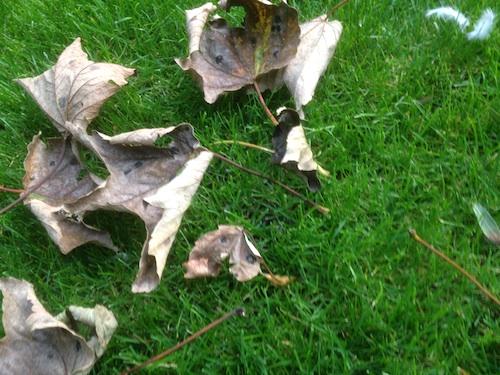October Gardening Tips
| Author: Gardeners Corner | Published: 2nd October 2013 11:57 |
 Autumn Leaves
Autumn Leaves
Sudbury and Suffolk October Gardening Tips
General tasks and garden maintenance
Tidy borders
Keep on weeding and have a gentle tidy up in your borders but do try to resist the temptation of a thorough spring clean. Leave seedheads for the birds if you don't want to collect them and as much cover as you can bear for wildlife who will appreciate the winter shelter.
Fallen leaves can be left to rot down (or collected for leaf mould), however diseased material is another matter; make it a priority to clear and burn it to prevent pests and diseases overwintering courtesy of your kind hospitality! Put the rest of your garden rubbish (apart from woody stems) in the compost.
Start your compost
If you haven't already done so, start your compost going by buying a bin or building a partially enclosed area for a heap. It is vital to replace the goodness in soil after a hefty growing season and autumn produces masses of garden waste that will put invaluable organic richness back into the ground for next spring. Add a variety of different materials; spent vegetable and bedding plants, herbaceous leftovers, thatch, moss and cuttings from the lawn, weeds (but not the roots unless they have been through a shredder), hedge clippings, kitchen peelings and tea bags are ideal.
Turn once a week or so if you can and NEVER add diseased or pest-ridden material (such as diseased rose petals - heinous culprits) to your compost - it is a warm and welcoming nirvana for unwelcome guests who will reappear with a vengeance next year! Onto the bonfire with them without a qualm...
Clean out the greenhouse
It really is worth cleaning out your greenhouse thoroughly now your greenhouse crops are over; it will prevent pests from hibernating and leaping into action next spring! Wash the windows inside and out to allow maximum light in over the winter and scrub all benches, fixtures and glazing bars with disinfectant, making sure you hose the whole place down really well, especially dark and dusty corners. For effective fumigation, move all plants outside, shut the windows, light a sulphur candle in the middle of the floor, (retreat at speed!), shut the door and wait until the smoke and fumes have completely dispersed several hours later. Your greenhouse should now be pest free!
Prepare your soil for next year
Your soil is your most precious commodity, so start digging in compost, manure and as much organic matter as you can lay your hands on to replace the goodness in it. The earlier you start the better, especially if your soil is heavy. It can be left in a pretty rough state over the winter when the elements will break the clods down, making spring planting infinitely easier!
Watering
Hardly an issue at the moment! However, do keep an eye on your pots and containers in dry spells and check for wilting leaves before it is too late; all plants that keep their leaves continue to transpire, so should not be allowed to dry out completely.
Ensure trees or shrubs planted in the last couple of years on lawns or in areas of rough grass have a circle of clear earth around them - this should be kept clear to allow moisture to get to the roots. Mulching with bark or compost will help.
Planting
With the ideal planting conditions of autumn (warm moist soil), now is the time to plant container grown shrubs, trees, fruit bushes, perennials and bulbs. Even in damp conditions it is worth checking the rootballs of shrubs and trees are adequately moist when planting - heavy rain will not necessarily penetrate a rootball that has been allowed to dry out, so if it feels light, plunge into a bucket of water before planting.
Rake fallen leaves
Don't waste fallen leaves (except those perilous rose leaves and evergreens, which take too long to rot down) - given time they decompose into fabulously rich leaf mould - aka 'nature's soil conditioner of choice'! Rake up fallen leaves and chuck them into a simple frame to make leaf mould (black bin liners spiked with air holes will also do if you can bear the visual offense - but remember to dampen the leaves first). If left to linger on the lawn for long, the grass will turn yellow. Leaf mould takes about a year to mature (2 in the case of oak leaves), makes a great top dressing for woodland plants such as rhododendrons and is an excellent and FREE home-grown substitute for peat.
Report this article as inappropriate
Comments
You need to log in before you can do that! It's only a quick registration process to join the AMA network and completely free.



 Help
Help

 Business Reviews
Business Reviews Loading...
Loading...


 Help
Help